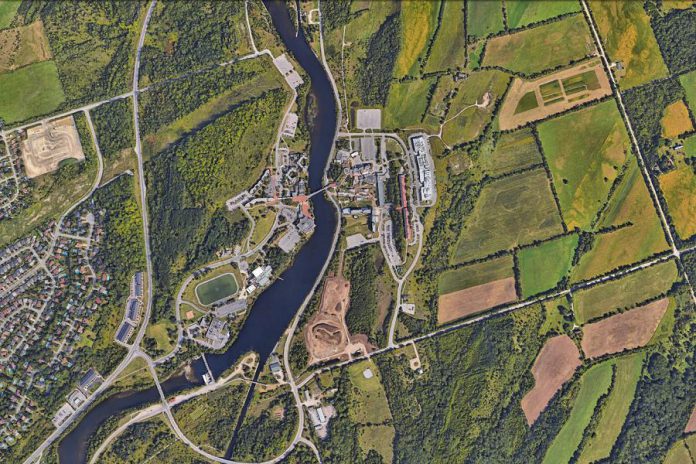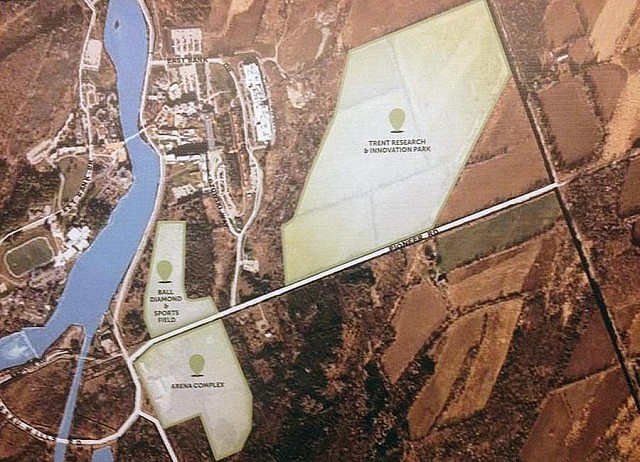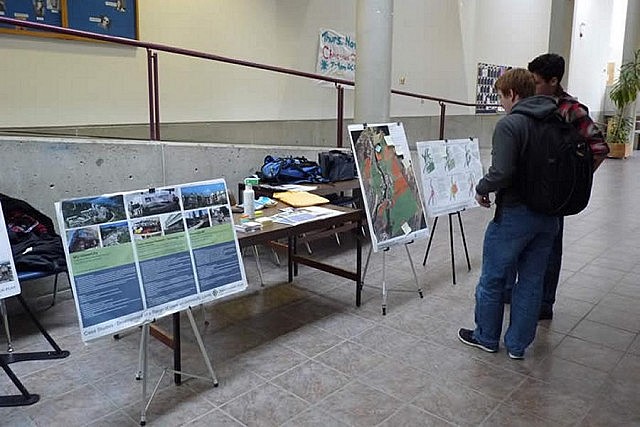
Last night before a packed crowd at Gzowski College, officials from Trent University and the City of Peterborough pulled back the curtain on the multi-million dollar multi-use development of 130 acres of university land.
Trent University president Leo Groarke and City director of planning Malcolm Hunt took turns at the podium, joined by City manager of facilities and special projects Mary Gallop, Trent’s vice-president of research and innovation Neil Emery, and Julie Davis, Trent’s vice-president of external relations and development.
Each addressed a different aspect of the project that will see as its key components the development of the Trent Research and Innovation Park, a twin-pad hockey arena, a major league-sized baseball field, and a natural turf multi-use sports field.
Work is well underway on the latter two components, with a projected opening of this summer.
The cornerstone of the project is the Trent Research and Innovation Park, an 85-acre development on the university’s East Bank. According to Emery, two tenants — Peterborough-based bioproducts company Noble Tech Inc. and wind-to-water innovator Rainmaker International of The Netherlands — have already signed on as tenants.
Emery pointed to Trent’s research expertise as a key factor in moving ahead with the project.
“We’ve had enough of keeping that a secret,” he said, noting there are 26 research parks across Canada that call universities home, generating an estimated $4.3 billion collectively for their host communities and employing more that 65,000 people.

Afterwards, Mr. Hunt praised the research park component as “transformational” in terms of its impact.
“It will not only shake up our economy and give it a solid footing for a new age of economic activity, but it’s also a project that’s a signal of hope and better opportunity for the citizens of Peterborough,” Hunt said.
“We’ve often talked within City Hall about the pillars of what makes our total economy work. We regard education as one of those really essential sectors. For a city this size to have both a university and a college is quite a remarkable thing, so it’s a tremendous economic infusion for the education sector.But we also identified innovation as the hallmark of our manufacturing base going forward. This is the blending of those two strengths in one project.”
Groarke agreed, saying “Our hope is this is a project that brings the university and the community together. Maybe it’s even broader than that. If we’re very successful, we’re going to develop an economic backbone for Peterborough and maybe even beyond Peterborough, as sort of a gateway to eastern Ontario.”
Located off Pioneer Road, the research park is being developed with five distinct goals well in mind: increases in economic development for the region, contributions to global sustainability initiatives, career opportunities for university students, research and analytical services for university labs and faculty, and experiential learning opportunities for students.
In working closely with Mr. Hunt, the university administration is preaching to the converted.
“I’m a graduate of the University of Waterloo and I look at what has happened since the emergence there of the David Johnston Research Park,” noted Mr. Hunt. “It’s forecasted when the David Johnston Research Park is complete, there will be 9,000 technology jobs together with 4,000 academic jobs. There are 1,500 faculty here. Take that kind of proportion and think about what 3,000 jobs could do for the City of Peterborough.”
Hunt also pointed out that Trent Research and Innovation Park will provide opportunites to encourage Trent University students to stay in Peterborough after they graduate.
“We’ve lamented the loss of our youth to other communities,” Hunt said. “The research park has the potential to give the brightest minds at Trent a chance to make Peterborough their home forever, to develop a career and raise their families in the place they call home.”
For her part, Gallop spoke directly to the development’s recreational use component.
The new arena, to rise at Pioneer Road and Nassau Mills Road, will replace aging Northcrest Arena, and also include an indoor running/walking track, a team workout facility, and a restaurant/canteen. It’s anticipated that construction of the first phase will begin in 2017, with the opening projected for 2019.
The natural turf baseball field, costing almost $2 million, is three-quarters funded by the City with the remainder coming from Trent University, the Peterborough Baseball Association, the Peterborough Recreational Baseball Association and the Jays Care Foundation.
In addition to the development of an adjacent sports field for soccer, rugby and field lacrosse, the university has committed to reserving an additional 23 acres of land for a term of 15 years for future recreational use consideration and development.
In her remarks, Davis gave an overview of the process to date, surprising some by noting that university property comprises 10 per cent of all land in the city. Of its total 1,450 acres, 400 acres is designated for endowment.
Davis also provided an overview of the project’s journey to this point, which has arisen out of the original 1964 Master Plan and decades of planning since. Community consultations in 2012-13 were followed by the June 2013 approval of the Trent Lands Plan by the university’s board of governors.

“This is a time when any university needs to think carefully about what assets it has and use those assets to maximize its potential,” he said. “One of the strategies at Trent University is we’re going to make it through a very difficult and challenging time by taking an asset, that land, and using it in ways that make sense from an academic and fiscal point of view and make sense from Peterborough’s point of view.”
“It’s a very dynamic, fluid time for Trent University,” Groarke added. “In the last two years, the developments are almost dizzying. The Student Centre project, the sports fields, the research park and, if all goes well, in three or four years, we’ll be talking about a sustainable village. That’s tremendous development in a short period of time.”
From the City’s perspective, Mr. Hunt said the City’s partnership with Fleming College to develop the Sport and Wellness Centre provided one important lesson that has come into play in this venture.
“A partnership works best when both parties are equally invested,” he said. “In the case of the Wellness Centre, one of our most successful partnerships ever, the college and the City were equally invested. It wasn’t just making land available; the college became a financial partner.”
“The university has really come to the table with us on this endeavor, so they have as much skin in the game as the City does,” Hunt said. “Because of that, they’re going to market the living daylights out of it, and we’re going to market the living daylights out of it. The risks around capital costs, we’re beginning to share those more. We’re adopting the lessons learned from successful partnerships.”
For more background on the Trent Lands Plan, visit www.trentu.ca/trentlandsplan/.


























